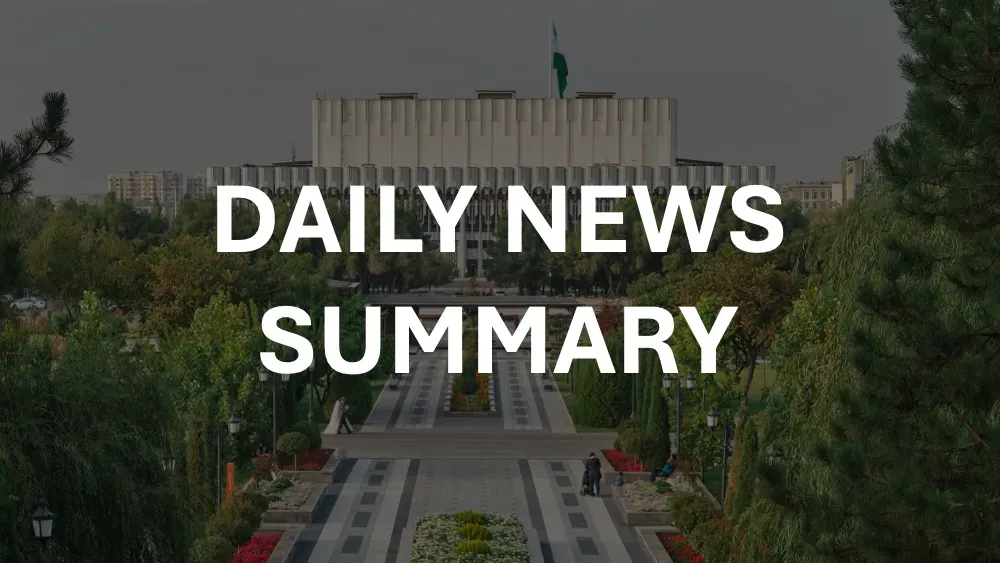📍 Get daily intelligence from Kyrgyzstan and Central Asia. Lexica News delivers local news that shapes global decisions—synthesized from local sources international media misses.
Construction crews broke ground in December 2024 on a railway project that will fundamentally alter Central Asian trade dynamics: the China-Kyrgyzstan-Uzbekistan (CKU) railway, representing the largest infrastructure investment in Kyrgyzstan's history. With a total project cost of $8 billion, the 523-kilometer railway will connect China's western Xinjiang region to Central Asia through Kyrgyzstan, bypassing the traditional Kazakhstan route that currently handles over 32 million tons annually. For a country with a GDP of $17.48 billion, this railway represents both unprecedented opportunity and substantial financial risk, as Kyrgyzstan commits to borrowing $2.35 billion from China while already owing Chinese creditors 42% of its existing government debt.
Current Landscape: Breaking Ground After Decades of Delays
The CKU railway project entered its construction phase following the December 2024 launching ceremony in Jalalabad, marking the end of over two decades of planning and false starts. The 523-kilometer route will stretch from Kashgar in China's Xinjiang region through the Torugart Pass, continue through Kyrgyzstan to Jalalabad, and terminate in Andijan, Uzbekistan.
The project's complexity becomes apparent in its engineering requirements. Three major tunnels will pierce the Tian Shan mountains: the 12.5-kilometer Naryn tunnel, the 13.2-kilometer Koshtoba tunnel, and the 12.2-kilometer Fergana Mountain tunnel. These tunnels represent approximately 38 kilometers of the 280-kilometer Kyrgyz section, highlighting the challenging terrain that has previously deterred similar projects.
China's financial commitment exceeds simple infrastructure funding. Beijing provides $2.35 billion in low-interest loans plus an additional $1.2 billion direct investment, securing a 51% ownership stake. Kyrgyzstan and Uzbekistan each contribute approximately $700 million for 24.5% stakes respectively through their national railway companies.
The project timeline spans six years from the 2025 construction start, with designed speeds of 120 kilometers per hour. This represents a significant upgrade from Kyrgyzstan's existing railway infrastructure, which consists of only 424 kilometers of disconnected track serving isolated regions in the north and south.
Current regional trade flows demonstrate the project's strategic timing. China-Kazakhstan railway freight reached a record 32 million tons in 2024, representing a 13% increase from the previous year's 28.3 million tons. The China-Central Asia trade volume reached $89.4 billion in 2023, growing 27% year-on-year, indicating substantial cargo volumes that could potentially utilize the new route.
Documented Experiences: Financial Burden and Technical Challenges
Kyrgyzstan's experience financing large-scale Chinese infrastructure projects provides context for assessing the CKU railway's prospects. The country's total public debt of $6.6 billion represents 37.6% of GDP, with the Export-Import Bank of China holding $1.65 billion or 36% of external debt.
Previous Chinese-funded projects illustrate both opportunities and risks. The modernization of Bishkek's main power plant by China's TBEA cost nearly $400 million, yet the facility broke down in freezing temperatures just four years later in January 2018, leaving the capital without power during winter. Similarly, the north-south highway project faced corruption charges that led to Prime Minister Sapar Isakov's imprisonment, demonstrating governance risks associated with large-scale Chinese investments.
Trade deficit patterns reveal another documented challenge. Chinese exports to Kyrgyzstan totaled $7.5 billion while imports reached only $80 million in the period following BRI implementation, creating a 47% wider trade deficit between 2013 and 2021. This pattern suggests that Chinese infrastructure investments typically facilitate imports rather than boost local exports.
Technical integration challenges emerge from gauge differences. China operates on 1,435-millimeter standard gauge while Kyrgyzstan and Uzbekistan use 1,520-millimeter broad gauge, requiring either cargo transshipment or wheel replacement at borders. This technical incompatibility adds operational complexity and costs that existing routes through Kazakhstan avoid.
Environmental and social assessments remain limited in publicly available documentation. The route passes through mountainous terrain requiring 38 kilometers of tunnel construction, yet comprehensive environmental impact studies and community consultation processes have received minimal public disclosure.
Construction capacity represents another documented concern. Kyrgyzstan has not built new railway infrastructure since independence, meaning the project relies entirely on Chinese engineering expertise and construction management, potentially limiting local skill development and increasing dependency.
Stakeholder Realities: Government Promises Versus Economic Constraints
Government projections paint an optimistic picture of the railway's economic impact. President Sadyr Japarov estimates the project will generate $200 million annually for Kyrgyzstan, while Prime Minister Akylbek Zhaparov describes the railway as a "road of life" that will transform Kyrgyzstan into a commercial and industrial center.
However, economic analysts present more cautious assessments. The Center for Global Development identifies Kyrgyzstan as one of eight countries at high risk of debt distress from BRI projects, with debt-to-GDP ratios projected to exceed 50% once lending is complete. The railway's $4.7 billion cost for the Kyrgyz section represents over 26% of the country's current GDP, creating substantial repayment obligations.
International financial institutions express mixed perspectives. The World Bank's Country Partnership Framework for 2024-2028 supports infrastructure development but emphasizes debt sustainability concerns. The IMF's 2025 Article IV consultation notes Kyrgyzstan's improved fiscal performance but warns of rising expenditure pressures.
Business community perspectives remain limited in public discourse. Small and medium enterprises, which comprise the majority of Kyrgyzstan's private sector, have minimal documented input regarding potential benefits or concerns about the project's impact on local markets and competition.
Regional partners present varying levels of enthusiasm. Uzbekistan actively supports the project as it provides direct railway access to China, potentially reducing transit times from 45-70 days through Kazakhstan to significantly shorter periods. Kazakhstan views the project as potential competition to its dominant regional transit role, though officials maintain diplomatic support publicly.
Russian perspectives remain largely unstated in official channels, though the project clearly provides Central Asian countries with reduced dependence on Russian-controlled northern routes. This strategic shift occurs as Russia faces international sanctions that complicate its role as a regional transit hub.
Chinese stakeholders emphasize connectivity benefits while maintaining discretion regarding financial arrangements. China's state media describes the project as enhancing regional connectivity and strengthening Belt and Road Initiative implementation, focusing on mutual benefit rhetoric rather than specific commercial terms.
Understand Kyrgyzstan Like an Insider
This analysis draws from extensive research, but the story continues to evolve daily. Lexica synthesizes breaking developments from dozens of Kyrgyz news sources—from mining policy changes to local protests that never make international headlines.
Our daily intelligence briefs help executives, diplomats, and researchers track:
- Regulatory shifts affecting foreign investment
- Local opposition to development projects before they escalate
- Market dynamics that signal opportunity or risk
- Political developments that reshape the business landscape
Operational Context: Costs, Timelines, and Regulatory Processes
The CKU railway's operational framework reveals complex financial and regulatory arrangements. Construction costs break down into $4.7 billion for the 280-kilometer Kyrgyz section and approximately $3.3 billion for remaining portions. Per-kilometer costs average $16.8 million, reflecting the challenging mountainous terrain and tunnel requirements.
Financing structures demonstrate Chinese development banking practices. The $2.35 billion Export-Import Bank of China loan likely carries concessional interest rates typical of BRI projects, though specific terms remain undisclosed. Kyrgyzstan's initial $14 million contribution represents approximately 0.3% of the total project cost, with additional payments spread across three years.
Timeline projections indicate six-year construction beginning in July 2025, though similar BRI projects frequently experience delays. The project's complexity, involving three countries with different regulatory systems and languages, adds coordination challenges that simple bilateral projects avoid.
Cargo capacity estimates suggest 15 million tons annual throughput once fully operational. This volume would represent approximately 47% of current China-Kazakhstan railway traffic, indicating potential significant trade diversion from existing routes.
Regulatory processes demonstrate limited transparency in project development. Environmental assessments, community consultations, and detailed feasibility studies remain largely inaccessible to public scrutiny. The rapid progression from agreement signing to construction start suggests streamlined approval processes that may bypass typical infrastructure development protocols.
Operational challenges include gauge conversion requirements at the China-Kyrgyzstan border. Standard gauge to broad gauge transitions require either time-consuming cargo transfers or specialized equipment for wheelset changes, potentially negating some transit time advantages.
Maintenance and operational staffing represent ongoing cost considerations not fully addressed in public documentation. Kyrgyzstan's limited railway experience necessitates extensive technical assistance or foreign management, creating long-term operational dependencies beyond initial construction.
Border procedures and customs integration across three countries require harmonization efforts that could significantly impact transit efficiency. Current trade procedures between Central Asian countries often involve lengthy documentary requirements and inspection processes.
Regional Comparison: Positioning Against Established Trade Routes
The CKU railway enters a competitive regional landscape dominated by established infrastructure networks. Kazakhstan maintains the primary China-Europe transit route through its 16,000-kilometer railway network, handling 32 million tons of China-bound freight in 2024. The Dostyk-Alashankou junction point alone processes 20 million tons annually with capacity for 28 million tons across both border stations.
Uzbekistan's existing railway infrastructure spans 7,400 kilometers with planned $1 billion modernization investments in 2025, including 65% network electrification. This existing capacity provides operational redundancy and alternative routing options that the single-line CKU railway initially cannot match.
Transit time comparisons reveal potential CKU advantages. Current China-Uzbekistan cargo routing through Kazakhstan requires 45-70 days, while the CKU railway promises one-week time savings and 900-kilometer distance reduction for China-Europe routes. However, these advantages assume efficient border crossings and minimal technical delays.
Investment scales demonstrate regional infrastructure competition intensity. Kazakhstan plans $5 billion railway modernization including the Darbaza-Maktaaral project designed for 20+ million tons annual capacity. Uzbekistan commits over $1 billion in 2025 railway investments, indicating substantial regional spending on transport infrastructure.
Cargo distribution patterns show Kazakhstan's current dominance in regional transit flows. Main transit destinations include Uzbekistan (45%), Kyrgyzstan (20%), and other Central Asian countries, demonstrating existing traffic that the CKU railway must capture or supplement.
Economic development levels vary significantly across regional railway operators. Kazakhstan's GDP exceeds $220 billion, providing substantial fiscal capacity for infrastructure investment and maintenance. Uzbekistan's economy approaches $80 billion, while Kyrgyzstan's $17.48 billion GDP limits its financial flexibility for railway operations and expansion.
Technical standards alignment creates operational advantages for some regional players. Kazakhstan and Russia share 1,520-millimeter broad gauge systems, enabling seamless rolling stock movement across extensive networks. The CKU railway's gauge conversion requirements at the Chinese border add operational complexity absent in northern routes.
Conclusion: Opportunity and Risk in Equal Measure
The China-Kyrgyzstan-Uzbekistan railway represents Central Asia's most ambitious infrastructure project in decades, promising to reshape regional trade dynamics through reduced transit times and alternative routing options. Construction progress indicates Chinese commitment to Belt and Road Initiative expansion despite previous project delays, while Kyrgyzstan's participation demonstrates willingness to accept substantial financial obligations for potential economic transformation.
Current data reveals significant trade volumes flowing through existing Kazakhstan-controlled routes, suggesting market demand for additional capacity and competition. The 32 million tons of China-Kazakhstan railway traffic and $89.4 billion China-Central Asia trade volume provide evidence that cargo volumes exist to support multiple transport corridors.
However, financial sustainability concerns persist given Kyrgyzstan's existing debt burden and limited fiscal capacity. The $4.7 billion Kyrgyz section cost exceeds 26% of national GDP, creating repayment obligations that depend entirely on projected transit revenue generation. Previous Chinese-funded projects in Kyrgyzstan experienced operational challenges and corruption issues, suggesting implementation risks beyond financial considerations.
Technical integration challenges including gauge conversion requirements and complex mountainous terrain engineering add operational uncertainties not present in established northern routes. The project's success ultimately depends on efficient border procedures, reliable technical operations, and sufficient cargo demand to justify the substantial investment costs.
Regional competition intensifies as Kazakhstan invests billions in railway modernization while maintaining established operational advantages through existing infrastructure networks and technical compatibility with Russian systems. The CKU railway must capture market share while managing higher per-unit costs associated with tunnel operations and gauge conversions.
Monitoring indicators include construction progress against timeline targets, cargo volume development once operational, financial performance metrics for debt service capability, and regional trade flow patterns as multiple corridors compete for China-Europe transit business. The project's ultimate success will depend on balancing infrastructure connectivity benefits against the financial and operational challenges inherent in this complex tri-national undertaking.
Frequently Asked Questions
What is the current construction status of the China-Kyrgyzstan-Uzbekistan railway?
Construction officially began in December 2024 following the launching ceremony in Jalalabad, Kyrgyzstan. The project follows a six-year timeline beginning July 2025, with completion targeted for 2031. Initial construction activities focus on surveying and preliminary site preparation, while major tunnel construction will begin in subsequent phases.
How much will the railway cost and who pays for it?
The total project cost reaches $8 billion for the 523-kilometer route, with $4.7 billion allocated to Kyrgyzstan's 280-kilometer section. China provides $2.35 billion in low-interest loans plus $1.2 billion direct investment, securing 51% ownership. Kyrgyzstan and Uzbekistan contribute approximately $700 million each for 24.5% stakes.
What cargo volume can the railway handle compared to existing routes?
The CKU railway is designed for 15 million tons annual capacity once fully operational. This represents approximately 47% of current China-Kazakhstan railway traffic, which reached 32 million tons in 2024. Kazakhstan's existing infrastructure processes 20-28 million tons annually through major border crossings.
How will the railway impact existing trade routes through Kazakhstan and Russia?
The CKU railway offers one-week time savings and 900-kilometer distance reduction compared to northern routes through Kazakhstan and Russia. Current China-Uzbekistan transit through Kazakhstan requires 45-70 days, while the new route promises significant improvements. However, the CKU railway's 15-million-ton capacity limits its ability to replace existing high-volume corridors entirely.
What are the technical challenges for operating trains across three countries?
The primary technical challenge involves gauge differences: China uses 1,435-millimeter standard gauge while Kyrgyzstan and Uzbekistan operate 1,520-millimeter broad gauge. This requires cargo transshipment or specialized wheelset-changing equipment at borders. Additionally, three major tunnels totaling 38 kilometers through mountainous terrain present construction and maintenance challenges not found in northern routes across Kazakhstan's plains.
What economic benefits does Kyrgyzstan expect from the railway?
President Sadyr Japarov projects $200 million annual revenue for Kyrgyzstan from transit fees and related services. The government identifies 23 mineral deposits along the route including coal, gold, aluminum, and iron for potential development. However, economists note the country's limited export base and express concerns about debt sustainability given the project's $4.7 billion cost relative to Kyrgyzstan's $17.48 billion GDP.
How does the railway fit into China's Belt and Road Initiative?
The CKU railway represents a key Belt and Road Initiative project creating alternative connectivity between China and Central Asia. It supports China's Middle Corridor strategy by providing routes that bypass Russian territory, particularly important given current geopolitical tensions. The project follows typical BRI financing patterns with Chinese state banks providing majority funding and Chinese companies leading construction while local partners contribute smaller equity stakes.
Track Kyrgyzstan with Local Intelligence
The rare earth story exemplifies why local sources matter. While international media reports MOUs and ministerial visits, Uzbek outlets cover the community protests, water disputes, and regulatory changes that actually determine project outcomes.
Lexica delivers what you're missing:
- Daily briefs at 7AM Bishkek time covering 40 top stories from politics to economics
- Full-text synthesis from sources in Kyrgyz
- Searchable archive to track how today's announcements connect to yesterday's promises
- Multi-country coverage across Central Asia for regional context
Whether you're evaluating investment opportunities, monitoring supply chain risks, or analyzing geopolitical developments, local intelligence reveals what international headlines obscure.










